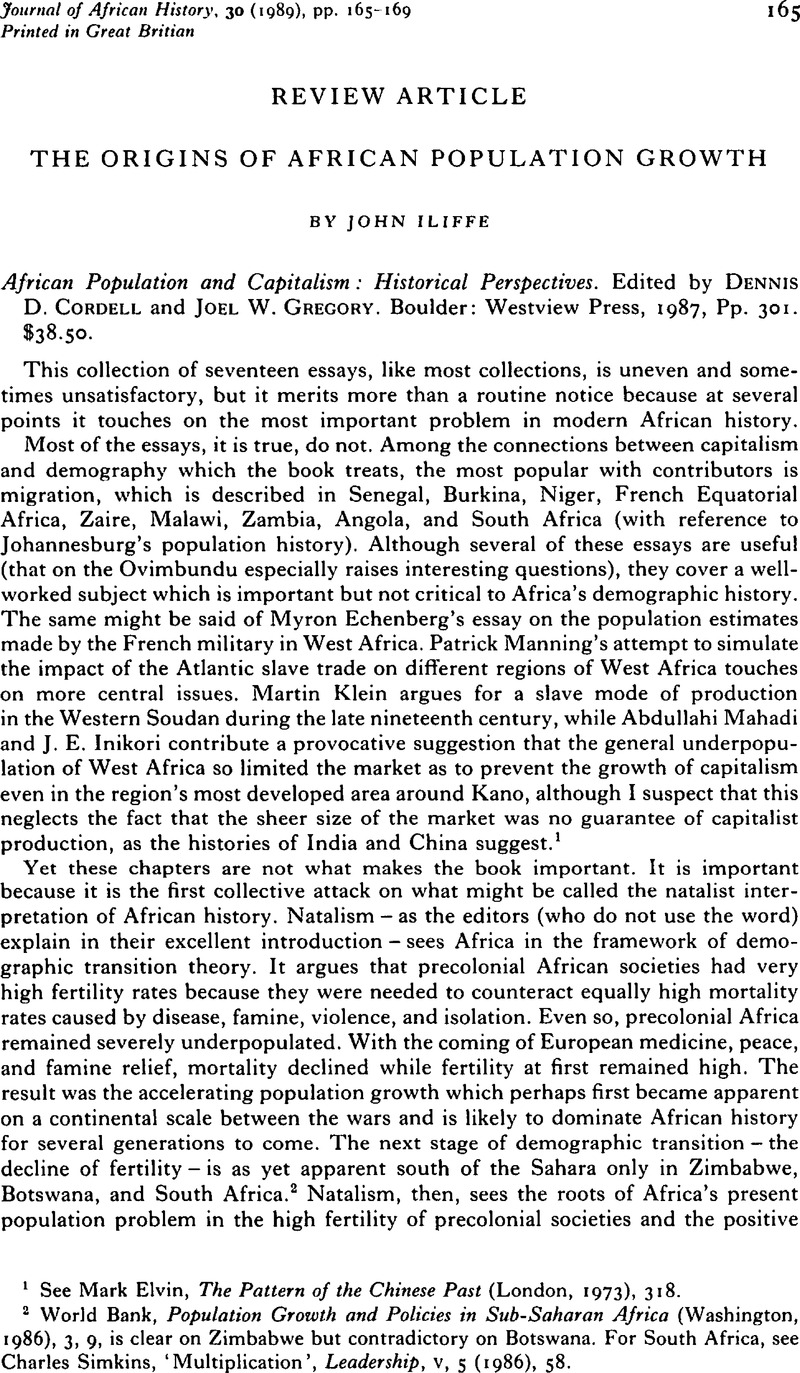Article contents
The Origins of African Population Growth
Published online by Cambridge University Press: 22 January 2009
Abstract

- Type
- Review Article
- Information
- Copyright
- Copyright © Cambridge University Press 1989
References
1 See Elvin, Mark, The Pattern of the Chinese Past (London, 1973), 318.Google Scholar
2 World Bank, Population Growth and Policies in Sub-Saharan Africa (Washington, 1986), 3, 9Google Scholar, is clear on Zimbabwe but contradictory on Botswana. For South Africa, see Simkins, Charles, ‘Multiplication’, Leadership, V, 5 (1986), 58.Google Scholar
3 Caldwell, J. C., ‘The social repercussions of colonial rule: demographic aspects’, in Boahen, A. Adu (ed.), UNESCO General History of Africa, VII (London, Paris and Berkeley. 1985), 458–86.Google Scholar
4 Kitching, Gavin, ‘Proto-industrialization and demographic change’, J. Afr. Hist., xxiv (1983), 221–40.CrossRefGoogle Scholar
5 Wrigley, E. A. and Schofield, R. S., The Population History of England 1541–1871: a Reconstruction (London, 1981).Google Scholar
6 Swindell, Kenneth, ‘Domestic production, labour mobility and population change in West Africa, 1900–80’, in Fyfe, Christopher and McMaster, David (eds.), African Historical Demography, II (Edinburgh, 1981), 675–83.Google Scholar
7 This problem is discussed, but not resolved, in my Famine in Zimbabwe, 1890–1960 (Gweru, forthcoming).Google Scholar
8 Ageron, Charles-Robert, Histoire de l'Algérie contemporaine, II (Paris, 1979), 471.Google Scholar
9 Perrot, Claude Hélène, Les Anyi-Ndenye et le pouvoir aux 18e et 19e siècles (Paris, 1982), 34, 149, 254, 296–7.Google Scholar
10 Fernandez, James W., Bwiti: an Ethnography of the Religious Imagination in Africa (Princeton, 1982), 110.Google Scholar
11 Müller, Wilhelm Johann, Die africanische auf der Guineischen Gold-Cust gelegene Landschaft Fetu (reprinted, Graz, 1968), 92.Google Scholar
12 Fernandez, , Bwiti, 355, 369, 427Google Scholar; Retel-Laurentin, Anne, Un pays à la dérive: les Nzakara de l'est centrafricain (Paris, 1979)Google Scholar; Belsey, Mark A., ‘The epidemiology of infertility’, Bulletin of the World Health Organization, LIV (1976), 326–30.Google Scholar
13 The respective deathrates were 38 and 17 per thousand. See Thornton, John, ‘An eighteenth-century baptismal register and the demographic history of Manguenzo’, in Fyfe, Christopher and McMaster, David (eds.), African Historical Demography (Edinburgh, 1977), 410Google Scholar; World Bank, World Development Report 1987 (New York, 1987), 257.Google Scholar
14 Fortes, Meyer, ‘A demographic field study in Ashanti’, in Lorimer, Frank (ed.), Culture and Human Fertility (Paris, 1954), 302Google Scholar; Gold Coast, Census of Population 1948 (London, 1950), 36Google Scholar; Rhodesia, , Census of Population 1969 (Salisbury [1971 ?]), 11.Google Scholar
15 It is accepted in India, whose rapid population growth also began in the 1920s, after a century of the colonial demands for labour and other pressures which Anti-Natalists emphasize. See Leela, and Visaria, Pravin, ‘Population (1757–1947)’, in Kumar, Dharma (ed.), The Cambridge Economic History of India, II (Cambridge, 1983), 488, 501, 508.Google Scholar
16 Trolli, G., ‘Contribution à l'étude de la démographie des Bakongo’, Institut Royal Colonial Beige: bulletin des séances, v (1934), 294–312.Google Scholar
17 Iliffe, John, A Modern History of Tanganyika (Cambridge, 1979), 315–16.CrossRefGoogle Scholar
18 See World Bank, Population Growth, 37Google Scholar; Caldwell, John C., ‘Routes to low mortality in poor countries’, Population and Development Review, XII (1986), 171.CrossRefGoogle Scholar
* As this article was being sent to press the Editors of the Journal learned with great regret of the death of Joel Gregory, on 29 July 1988.
- 6
- Cited by


